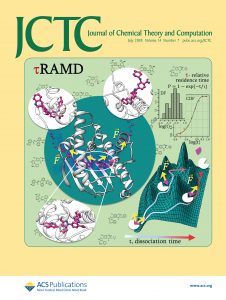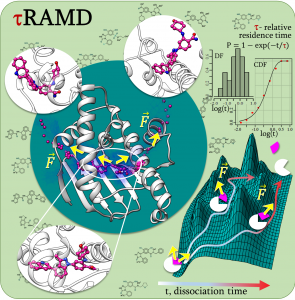New computational method for drug discovery
HITS researchers developed tauRAMD, a tool to predict drug-target residence times from short simulations. The method is illustrated on the cover page of July 2018 issue of the Journal of Chemical Theory and Computation, software is freely available.
The design of a drug with a desired duration of action, whether long or short, is usually a complicated and expensive trial-and-error process guided only by a mix of expert intuition and serendipity. One of the parameters affecting drug efficacy is the lifetime of the complex formed between a drug and its target protein, whose function must be altered, e.g. inhibited. In practice, many possible chemical compounds have to be synthesized and then tested to discover an appropriate drug candidate.
Easy method and high performance
As a part of the Kinetics for Drug Discovery (K4DD) project supported by the EU/EFPIA Innovative Medicines Initiative Joint Undertaking, researchers at the Molecular and Cellular Modeling (MCM) group at the Heidelberg Institute for Theoretical Studies (HITS) developed a computationally efficient and easy-to-use method for predicting the relative lifetimes of complexes of a target protein with different drug candidates. The scientists demonstrated the high predictive performance of the computational approach using experimental data measured by collaborators at Merck KGaA (Darmstadt), Sanofi-Aventis Deutschland (Frankfurt am Main), and Sanofi R&D (Vitry-sur-Seine, France).
The method, called tauRAMD (residence time, tau, estimation using Random Acceleration Molecular Dynamics simulations) has been developed for ease of use and makes it possible to compute long residence times with short simulations. It has been successfully applied to diverse sets of compounds binding a range of therapeutically important target proteins. It is described in an open-access publication (https://pubs.acs.org/doi/abs/10.1021/acs.jctc.8b00230), and the software is freely available here: http://www.h-its.org/downloads/ramd/
Publication:
Estimation of Drug-Target Residence Times by τ-Random Acceleration Molecular Dynamics Simulations. Daria Kokh*, Marta Amaral, Joerg Bomke, Ulrich Grädler, Djordje Musil, Hans-Peter Buchstaller, Matthias K. Dreyer, Matthias Frech, Maryse Lowinski, Francois Vallee, Marc Bianciotto, Alexey Rak, and Rebecca C. Wade*. J. Chem. Theory Comput., 2018, 14 (7), pp 3859–3869. DOI: 10.1021/acs.jctc.8b00230
*corresponding authors
Scientific contact:
Prof. Dr. Rebecca Wade
Molecular and Cellular Modeling Group
Heidelberg Institute for Theoretical Studies (HITS)
Phone: +49 6221 – 533 – 247
rebecca.wade@h-its.org
Media Contact:
Dr. Peter Saueressig
Head of Communications
Heidelberg Institute for Theoretical Studies (HITS)
Phone: +49 6221 533 245
peter.saueressig@h-its.org

About HITS
HITS, the Heidelberg Institute for Theoretical Studies, was established in 2010 by physicist and SAP co-founder Klaus Tschira (1940-2015) and the Klaus Tschira Foundation as a private, non-profit research institute. HITS conducts basic research in the natural, mathematical, and computer sciences. Major research directions include complex simulations across scales, making sense of data, and enabling science via computational research. Application areas range from molecular biology to astrophysics. An essential characteristic of the Institute is interdisciplinarity, implemented in numerous cross-group and cross-disciplinary projects. The base funding of HITS is provided by the Klaus Tschira Foundation.
